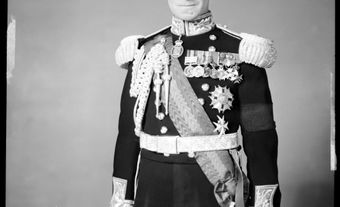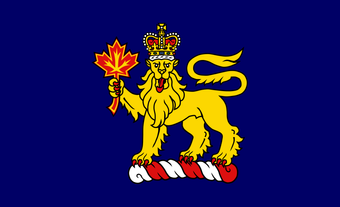Susan Charlotte Buchan, Baroness Tweedsmuir of Elsfield (née Grosvenor), author and viceregal consort of Canada from 1935 to 1940 (born 20 April 1882 in London, United Kingdom; died 22 March 1977 in Burford, United Kingdom). The author of several novels, children’s books and biographies, Lady Tweedsmuir founded the Lady Tweedsmuir Prairie Library Scheme to bring books to remote communities in Western Canada. She also encouraged the compilation of local history scrapbooks by the Federated Women’s Institutes of Canada and donated the Lady Tweedsmuir championship trophy for women’s curling.

Early Life
Susan Grosvenor was the daughter of Captain Honourable Norman de l’Aigle Grosvenor, a Liberal British Member of Parliament from 1869 to 1874, and Caroline Stuart-Wortley, a novelist and founder of the Women’s Farm and Garden Union (now the Working for Gardeners Association). She was a cousin of the Duke of Westminster. One of her childhood friends was future author Virginia Woolf. Susan and her younger sister Margaret were educated by a governess, and Susan later wrote in her memoir, The Lilac and the Rose, “I still mourn the fact that I was never taught to concentrate or to have exactness of mind when I was a child and that I was never told of their vital importance later in life.” After her father died when she was 16, Susan travelled extensively with her mother and sister in Germany, France and Italy, learning to speak fluent German and French. She worked at the Charity Organization Society office in London until her marriage.
Marriage and Children
Susan Grosvenor met Scottish novelist and historian John Buchan in 1905 through a mutual friend. On 15 July 1907, they were married at St. George’s in Hanover Square, London. The marriage was a happy one. In his posthumously published autobiography, Memory Hold-the-Door, Buchan wrote of his marriage, “I have been happy in many things, but all my other good fortune has been as dust in the balance compared with the blessing of an incomparable wife.” The couple settled in Elsfield Manor, near Oxford, after the First World War.
Susan and John Buchan had four children: Alice Caroline Fairfax-Lucy (1908–93), an author and archivist; John Norman Stuart, 2nd Baron Tweedsmuir (1911–44), a military officer, a naturalist and an explorer; William James de l’Aigle, 3rd Baron Tweedsmuir (1916–2008), a Royal Air Force pilot and poet; and Alastair Francis (1918–76), who served in the Canadian forces during the Second World War.
Early Literary Career
Both John and Susan Buchan were prolific authors, writing books side by side at desks in the library of their home. She wrote history books informed by research in the University of Oxford’s libraries, including The Sword of State: Wellington After Waterloo (1928) and Lady Louisa Stuart: Her Memories and Portraits (1932). Her 1935 book about Charlotte Stuart, Duchess of Albany, the illegitimate daughter of Charles Edward Stuart (Bonnie Prince Charlie), The Funeral March of a Marionette, was published by Leonard and Virginia Woolf’s publishing house, The Hogarth Press, in 1935 with a dust jacket designed by Virginia Woolf’s sister, artist Vanessa Bell. She also wrote children’s books. Buchan encouraged his wife to write her first novel. The Scent of Water (1937) was inspired by her experiences doing charitable work in Wales and written during her time as viceregal consort of Canada.

Viceregal Consort of Canada
On 1 June 1935, King George V made John Buchan the first Baron Tweedsmuir of Elsfield in honour of his appointment as governor general of Canada earlier that year. Susan Buchan became Lady Tweedsmuir and used Susan Tweedsmuir as a pen name for her later books. The new viceregal couple arrived in Canada on 2 November 1935.
As viceregal consort of Canada from 1935 until her husband’s death in 1940, Lady Tweedsmuir promoted literacy and the preservation of local history, travelling extensively and delivering lectures at women’s clubs. In October 1938, Lady Tweedsmuir received an honorary Doctor of Laws degree from the University of Toronto in honour of her literary career. In her acceptance speech, which was later published in the Canadian Historical Review, she praised the efforts of amateur historians who “sometimes help reveal something in the darkness of the past which has been left out or forgot in the march of time.” She was active in the Women’s Institute movement, becoming an honorary life member of the Federated Women’s Institutes of Ontario, and encouraged the rural women who belonged to these societies to compile scrapbooks of local history. These scrapbooks, known as Tweedsmuir Histories, are part of the collections of local archives in Canada today.
Lady Tweedsmuir wrote a volume about Canada for The British Commonwealth in Pictures series, which was published in 1941. She especially enjoyed her time at the Citadelle in Quebec City. Inspired by the 1830s diaries of Lady Louisa Anne Whitworth-Aylmer, wife of Matthew Whitworth-Aylmer, the Governor-in-Chief of Lower Canada from 1830 to 1835, Lady Tweedsmuir published her thoughts in these journals, as well as some of her own impressions of Quebec, as Carnets Canadiens in 1938.
During a 1936 train tour of Canada’s western provinces with her husband, Lady Tweedsmuir asked local residents how she could help them: many requested books. She established the Lady Tweedsmuir Prairie Library Scheme, collecting 40,000 books at Rideau Hall for distribution to remote communities in Western Canada. Lord and Lady Tweedsmuir toured the Maritime Provinces in 1937.
In 1938, Lady Tweedsmuir donated the Lady Tweedsmuir championship trophy to the Ladies Curling Association of the Canadian branch of the Royal Caledonian Curling Club. It was a counterpart to the Governor General’s Trophy for men’s curling, which had been established in 1875. Lady Tweedsmuir presented the trophy and medals for women’s curling annually at Rideau Hall (officially Government House). In 1939, Lady Tweedsmuir hosted King George VI and Queen Elizabeth (later the Queen Mother) in Ottawa on their six-week royal tour of Canada and the United States.

Later Life
Lady Tweedsmuir returned to the United Kingdom after the death of her husband in 1940 and lived at Elsfield Manor until 1953. During the Second World War, she provided hospitality for Canadian troops stationed nearby. In 1954, she moved to the town of Burford in the Cotswolds. She continued to be a prolific author, writing three short volumes of memoirs about her early life — The Lilac and the Rose (1953), A Winter Bouquet (1954) and The Edwardian Lady (1966) — and six novels, which included The Silver Ball (1944), The Rainbow Through the Rain (1950), A Winter Bouquet (1954), Cousin Harriet (1957), Dashbury Park (1959) and A Stone in the Pool (1961). Lady Tweedsmuir also wrote the forward to a commemorative volume about the coronation of Queen Elizabeth II in 1952.
Lady Tweedsmuir’s son William wrote in his biography of his father, “John Buchan’s popularity, as gauged by the continuing demand for his books, never suffered a serious slump, and much of the credit for this must be given to my mother, who, throughout 37 years of widowhood, worked tirelessly to keep her husband’s name alive.” She sold his 4,500-volume library to Queen’s University in Kingston, Ontario. In 1947, she published a volume of memories of her late husband, John Buchan, by his Wife and Friends. Lady Tweedsmuir also published anthologies of his writings and speeches and personally negotiated the broadcast rights for radio dramas and television adaptations of his work. Her conversations about Lord Tweedsmuir’s life and career informed biographies of him written by Janet Adam Smith in 1965 and her granddaughter Ursula Buchan in 2019.

 Share on Facebook
Share on Facebook Share on X
Share on X Share by Email
Share by Email Share on Google Classroom
Share on Google Classroom



